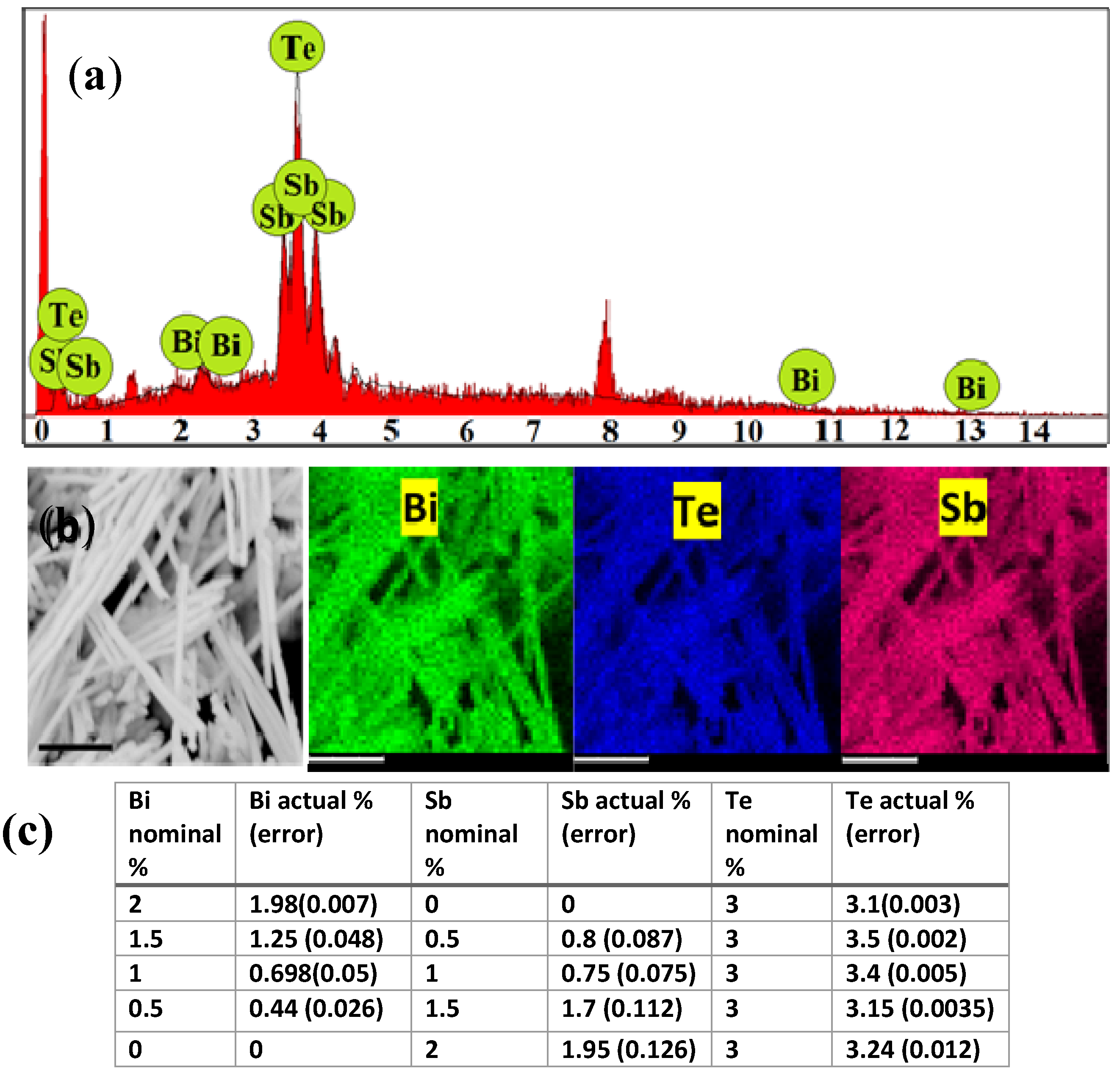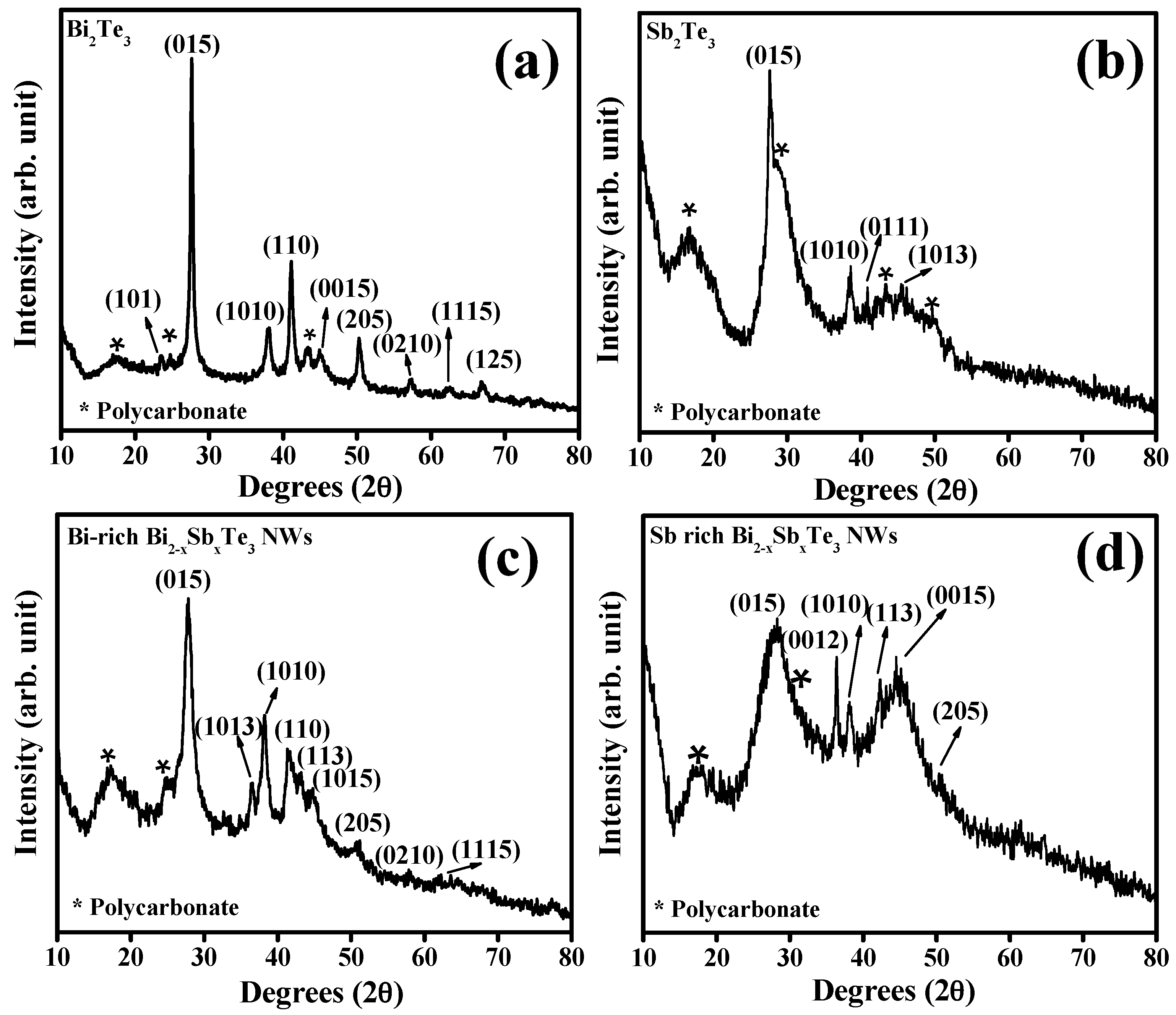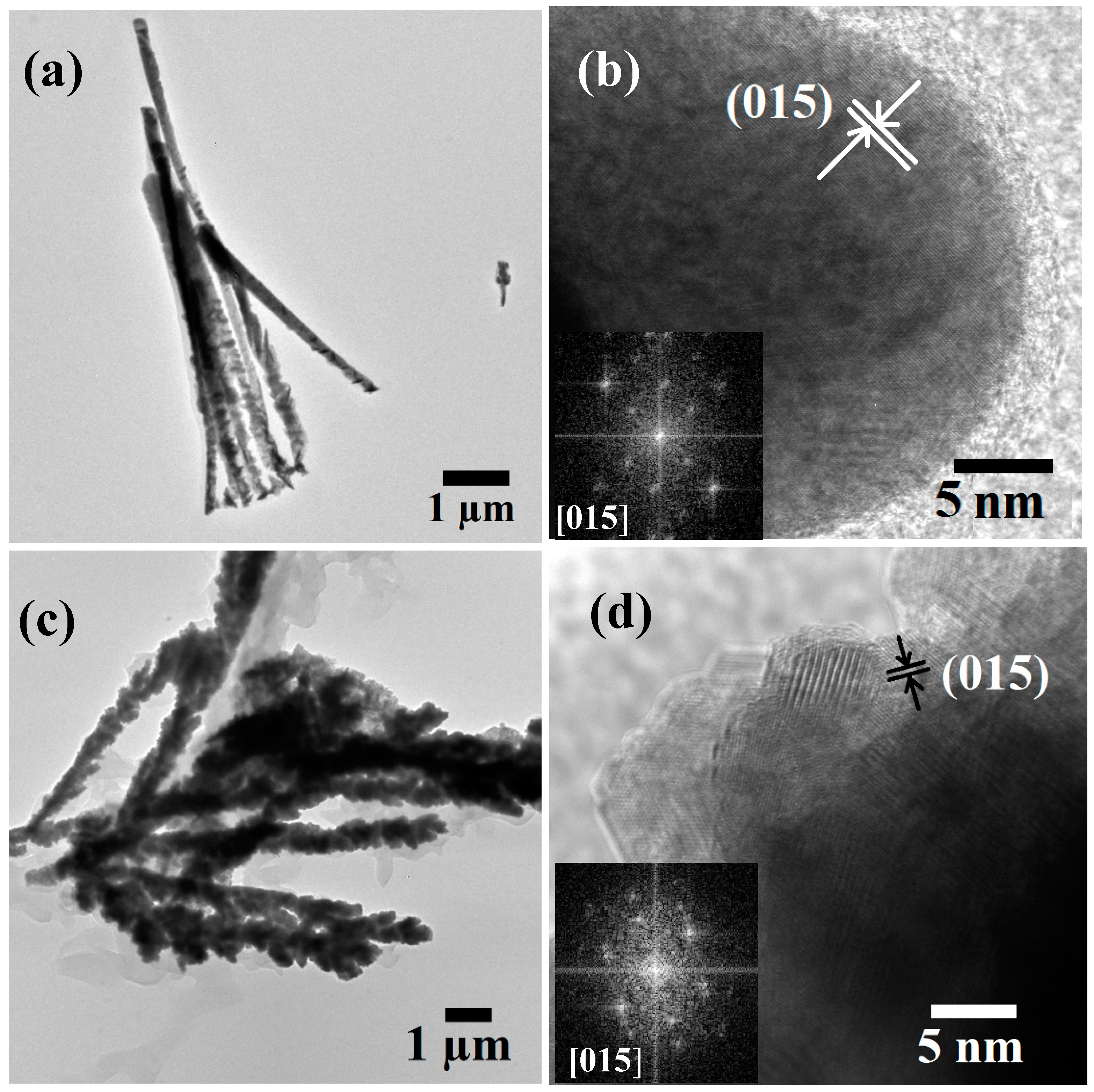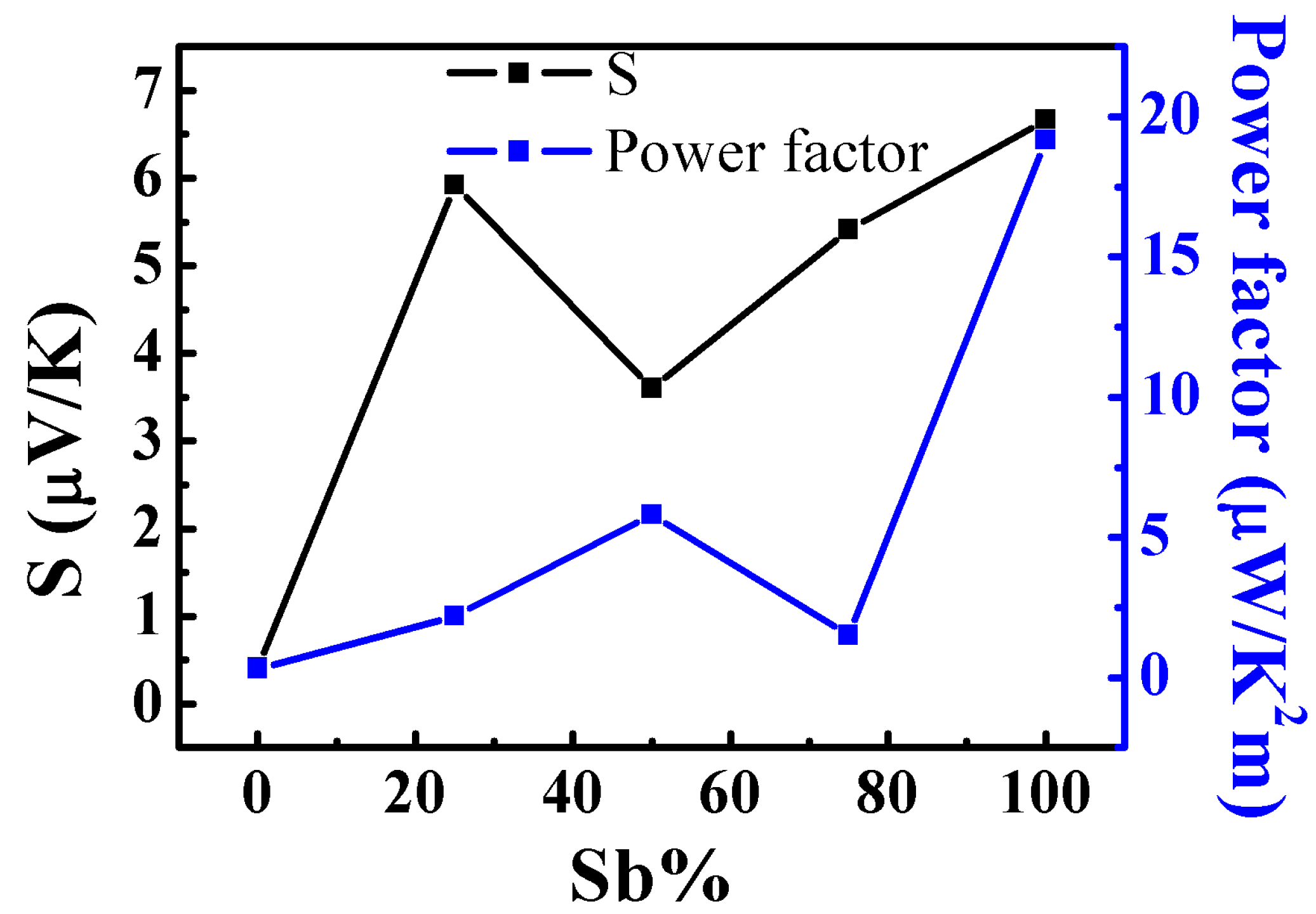Structure and Thermoelectric Properties of Bi2−xSbxTe3 Nanowires Grown in Flexible Nanoporous Polycarbonate Templates
Abstract
:1. Introduction
2. Materials and Methods
2.1. Template Preparation
2.2. Electrolyte Preparation
2.3. Electrodepositon Process
2.4. Characterization
2.5. Thermoelectric Property Measurements
3. Results and Discussion
4. Conclusions
Supplementary Materials
Acknowledgments
Author Contributions
Conflicts of Interest
References
- Bell, L.E. Cooling, heating, generating power, and recovering waste heat with thermoelectric systems. Science 2008, 321, 1457–1461. [Google Scholar] [CrossRef] [PubMed]
- Tritt, T.M.; Subramanian, M. Thermoelectric materials, phenomena and applications: A bird’s eye view. MRS Bull. 2006, 31, 188–194. [Google Scholar] [CrossRef]
- Rosenberg, Y.; Gelbstein, Y.; Dariel, M.P. Phase separation and thermoelectric properties of the Pb0.25Sn0.25Ge0.5Te compound. J. Alloys Compd. 2012, 526, 31–38. [Google Scholar] [CrossRef]
- Gelbstein, Y.; Dashevsky, Z.; Dariel, M.P. In-doped Pb0.5Sn0.5Te p-type samples prepared by powder metallurgical processing for thermoelectric applications. Physica B 2007, 396, 16–21. [Google Scholar] [CrossRef]
- Gelbstein, Y.; Davidow, J. Highly efficient functional GexPb1−xTe based thermoelectric alloys. Phys. Chem. Chem. Phys. 2014, 16, 20120–20126. [Google Scholar] [CrossRef] [PubMed]
- Gelbstein, Y. Phase morphology effects on the thermoelectric properties of Pb0.25Sn0.25Ge0.5Te. Acta Mater. 2013, 61, 1499–1507. [Google Scholar] [CrossRef]
- Kirievsky, K.; Shlimovich, M.; Fuks, D.; Gelbstein, Y. An ab initio study of the thermoelectric enhancement potential in nano-grained TiNiSn. Phys. Chem. Chem. Phys. 2014, 16, 20023–20029. [Google Scholar] [CrossRef] [PubMed]
- Kirievsky, K.; Gelbstein, Y.; Fuks, D. Phase separation and antisite defects in the thermoelectric TiNiSn half-Heusler alloys. J. Solid State Chem. 2013, 203, 247–254. [Google Scholar] [CrossRef]
- Sadia, Y.; Dinnerman, L.; Gelbstein, Y. Mechanical Alloying and Spark Plasma Sintering of Higher Manganese Silicides for Thermoelectric Applications. J. Elect. Mater. 2013, 42, 1926–1931. [Google Scholar] [CrossRef]
- Gelbstein, Y.; Tunbridge, J.; Dixon, R.; Reece, M.J.; Ning, H.P.; Gilchrist, R.; Summers, R.; Agote, I.; Lagos, M.A.; Simpson, K.; et al. Physical, Mechanical, and Structural Properties of Highly Efficient Nanostructured n- and p-Silicides for Practical Thermoelectric Applications. J. Elect. Mater. 2014, 43, 1703–1711. [Google Scholar] [CrossRef]
- Hicks, L.D.; Dresselhaus, M.S. Effect of quantum-well structures on the thermoelectric figure of merit. Phys. Rev. B 1993, 47, 12727–12731. [Google Scholar] [CrossRef]
- Dresselhaus, M.S.; Chen, G.; Tang, M.Y.; Yang, R.; Lee, H.; Wang, D.; Ren, Z.; Fleurial, J.P.; Gogna, P. New Directions for Low-Dimensional Thermoelectric Materials. Adv. Mater. 2007, 19, 1043–1053. [Google Scholar] [CrossRef]
- Heremans, J.P.; Thrush, C.M.; Morelli, D.T. Thermopower enhancement in PbTe with Pb precipitates. J. Appl. Phys. 2005, 98, 063703-1–063703-6. [Google Scholar] [CrossRef]
- Goldsmid, H.J. Thermoelectric Refrigeration; Plenum: New York, NY, USA, 1964; pp. 42–81. ISBN 978-1-4899-5723-8. [Google Scholar]
- Yim, W.M.; Rosi, F.D. Compound tellurides and their alloys for Peltier cooling—A review. Solid-State Electron. 1972, 15, 1121–1140. [Google Scholar] [CrossRef]
- Datta, A.; Paul, J.; Kar, A.; Patra, A.; Sun, Z.; Chen, L.; Martin, J.; Nolas, G.S. Facile Chemical Synthesis of Nanocrystalline Thermoelectric Alloys Based on Bi-Sb-Te-Se. Cryst. Growth Des. 2010, 10, 3983–3989. [Google Scholar] [CrossRef]
- Finefrock, S.W.; Yang, H.; Fang, H.; Wu, Y. Thrmoelectric Properties of Solution Synthesized Nanostructured Materials. Annu. Rev. Chem. Biomol. Eng. 2015, 6, 247–266. [Google Scholar] [CrossRef] [PubMed]
- Zheng, G.; Su, X.; Li, X.; Liang, T.; Xie, H.; She, X.; Yan, Y.; Uher, C.; Kanatzidis, M.G.; Tang, X. Toward High-Thermoelectric-Performance Large-Size Nanostructured BiSbTe Alloys via Optimization of Sintering-Temperature Distribution. Adv. Energy Mater. 2016, 6. [Google Scholar] [CrossRef]
- Xie, W.; Tang, X.; Yan, Y.; Zhang, Q.; Tritt, T.M. High thermoelectric performance BiSbTe alloy with unique low-dimensional structure. J. Appl. Phys. 2009, 105. [Google Scholar] [CrossRef]
- Popescu, A.; Woods, L.M. Enhanced thermoelectricity in composites by electronic structure modifications and nanostructuring. Appl. Phys. Lett. 2010, 97, 052102. [Google Scholar] [CrossRef]
- Minnich, A.J.; Dresselhaus, M.S.; Ren, Z.F.; Chen, G. Bulk nanostructured thermoelectric materials: Current research and future prospects. Energy Environ. Sci. 2009, 2, 466–479. [Google Scholar] [CrossRef]
- Chen, Z.G.; Han, G.; Yang, L.; Cheng, L.; Zou, J. Nanostructured thermoelectric materials: Current research and future challenge. Prog. Nat. Sci. Mater. Int. 2012, 22, 535–549. [Google Scholar] [CrossRef]
- Datta, A.; Popescu, A.; Woods, L.; Nolas, G.S. Chapter 14: The Bottom-Up Approach to Bulk Thermoelectric Materials with Nanoscale Domains in Materials, Preparation, and Characterization. In Thermoelectrics in Materials, Preparation, and Characterization in Thermoelectrics; Rowe, D.M., Ed.; CRC Press: New York, NY, USA, 2012; pp. 14-1–14-32. ISBN 978-1-4398-7470-7. [Google Scholar]
- Prieto, A.L.; Sander, M.S.; Gonzalez, M.M.; Gronsky, R.; Sands, T.; Stacy, A.M. Electrodeposition of Ordered Bi2Te3 Nanowire Arrays. J. Am. Chem. Soc. 2001, 123, 7160–7161. [Google Scholar] [CrossRef] [PubMed]
- Gonzalez, M.M.; Snyder, G.J.; Prieto, A.L.; Gronsky, R.; Sands, T.; Stacy, A.M. Direct Electrodeposition of Highly Dense 50 nm Bi2Te3−ySey Nanowire Arrays. Nano Lett. 2003, 3, 973–977. [Google Scholar] [CrossRef]
- Xiao, F.; Yoo, B.Y.; Lee, K.H.; Myung, N.S.V. Electro-transport studies of electrodeposited (Bi1−xSbx)2Te3 nanowires. Nanotechnology 2007, 18, 335203. [Google Scholar] [CrossRef]
- Zhang, G.; Yu, Q.; Li, X. Wet chemical synthesis and thermoelectric properties of V-VI one- and two-dimensional nanostructures. Dalton Trans. 2010, 39, 993–1004. [Google Scholar] [CrossRef] [PubMed]
- Frantz, C.; Stein, N.; Zhang, Y.; Bouzy, E.; Picht, O.; Toimil-Molares, M.E.; Boulanger, C. Electrodeposition of bismuth telluride nanowires with controlled composition in polycarbonate membranes. Electrochim. Acta 2012, 69, 30–37. [Google Scholar] [CrossRef]
- Picht, O.; Mueller, S.; Alber, I.; Rauber, M.; Falk, J.L.; Medlin, D.L.; Neumann, R.; T-Molares, M.E. Tuning the Geometrical and Crystallographic Characteristics of Bi2Te3 Nanowires by Electrodeposition in Ion-Track Membranes. J. Phys. Chem. C 2012, 116, 5367–5375. [Google Scholar] [CrossRef]
- Albrecht, T.T.; Schotter, J.; Kastle, G.A.; Emley, N.; Shibauchi, T.; Elbaum, L.K.; Guarine, G.; Black, C.T.; Touminen, M.T.; Russell, T.P. Ultrahigh-density nanowire arrays grown in self-assembled diblock copolymer templates. Science 2000, 290, 2126–2129. [Google Scholar] [CrossRef]
- Bal, M.; Ursache, A.; Tuominen, M.T.; Goldbach, J.T.; Russell, T.P. Nanofabrication of integrated magnetoelectronic devices using patterned self-assembled copolymer templates. Appl. Phys. Lett. 2002, 81, 3479–3481. [Google Scholar] [CrossRef]
- Martin, C.R. Nanomaterials: A membrane-based synthetic approach. Science 1994, 266, 1961–1966. [Google Scholar] [CrossRef] [PubMed]
- Hariri, M.B.; Dolati, A.; Moakhar, R.S. The Potentiostatic Electrodeposition of Gold Nanowire/Nanotube in HAuCl4 Solutions Based on the Model of Recessed Cylindrical Ultramicroelectrode Array. J. Electrochem. Soc. 2013, 160, D279–D288. [Google Scholar] [CrossRef]
- Boughey, F.L.; Davies, T.; Datta, A.; Whiter, R.A.; Sahonta, S.L.; Kar-Narayan, S. Vertically aligned zinc oxide nanowires electrodeposited within porous polycarbonate templates for vibrational energy harvesting. Nanotechnology 2016, 27. [Google Scholar] [CrossRef] [PubMed]
- Ou, C.; Sanchez-Jimenez, P.E.; Datta, A.; Boughey, F.L.; Whiter, R.A.; Sahonta, S.L.; Kar-Narayan, S. Template-Assisted Hydrothermal Growth of Aligned Zinc Oxide Nanowires for Piezoelectric Energy Harvesting Applications. ACS Appl. Mater. Interfaces 2016, 8, 13678–13683. [Google Scholar] [CrossRef] [PubMed]
- Smith, M.; Choi, Y.S.; Boughey, C.; Kar-Narayan, S. Controlling and assessing the quality of aerosol jet printed features for large area and flexible electronics. Flex. Print. Electron. 2017, 2. [Google Scholar] [CrossRef]
- Martin-Gonzalez, M.S.; Prieto, A.L.; Gronsky, R.; Sands, T.; Stacy, A.M. Insights into the Electrodeposition of Bi2Te3. J. Electrochem. Soc. 2002, 149, C546–C554. [Google Scholar] [CrossRef]
- Chang, T.; Cho, S.; Kim, J.; Schoenleber, J.; Frantz, C.; Stein, N.; Boulanger, C.; Lee, W. Individual thermoelectric properties of electrodeposited bismuth telluride nanowires in polycarbonate membranes. Electrochim. Acta 2015, 161, 403–407. [Google Scholar] [CrossRef]
- Sander, M.S.; Gronsky, R.; Sands, T.; Stacy, A.M. Structure of Bismuth Telluride Nanowire Arrays Fabricated by Electrodeposition into Porous Anodic Alumina Templates. Chem. Mater. 2003, 15, 335–339. [Google Scholar] [CrossRef]
- Budevski, E.; Staikov, G.; Lorenz, W.J. Electrochemical Phase Formation and Growth; VCH, Verlagsgesellschaft: Weinheim, Germany, 1996; p. 31. ISBN 3-527-29422-8. [Google Scholar]
- Bouroushian, M. Electrochemistry of Metal Chalcogenides. In Monographs in Electrochemistry; Schloz, F., Ed.; Springer: Berlin/Heidelberg, Germany, 2010; pp. 128–131. ISSN 1865-1836. [Google Scholar]
- Pinisetty, D.; Davis, D.; Podlaha-Murphy, E.J.; Murphy, M.C.; Karki, A.B.; Young, D.P.; Devireddy, R.V. Fabrication and characterization of electrodeposited antimony telluride crystalline nanowires and nanotubes. J. Mater. Chem. 2011, 21, 4098–4107. [Google Scholar] [CrossRef]
- Chen, C.L.; Chen, Y.Y.; Lin, S.J.; Ho, J.C.; Lee, P.C.; Chen, C.D.; Harutyunyan, S.R. Fabrication and Characterization of Electrodeposited Bismuth Telluride Films and Nanowires. J. Phys. Chem. C 2010, 114, 3385–3389. [Google Scholar] [CrossRef]
- Xu, E.; Li, Z.; Acosta, J.A.; Li, N.; Swartzentruber, B.; Zheng, S.J.; Sinitsyn, N.; Htoon, H.; Wang, J.; Zhang, S. Enhanced thermoelectric properties of topological crystalline insulator PbSnTe nanowires grown by vapor transport. Nano Res. 2016, 9, 820–830. [Google Scholar] [CrossRef]
- Kumar, P.; Pfeffer, M.; Peranio, N.; Eibl, O.; Bäßler, S.; Reith, H.; Nielsch, K. Ternary, single-crystalline Bi2 (Te, Se)3 nanowires grown by electrodeposition. Acta Mater. 2017, 125, 238–245. [Google Scholar] [CrossRef]
- Lee, P.; Chen, H.; Tseng, C.; Lee, C.; Chang, C.; Chen, Y. Thermoelectric Properties of an Individual Bi1.75Sb0.25Te2.02 Nanowire. Chin. J. Phys. 2013, 51, 854–861. [Google Scholar] [CrossRef]
- Bäßler, S.; Böhnert, T.; Gooth, J.; Schumacher, C.; Pippel, E.; Nielsch, K. Thermoelectric power factor of ternary single-crystalline Sb2Te3- and Bi2Te3-based nanowires. Nanotechnology 2013, 24, 495402. [Google Scholar] [CrossRef] [PubMed]
- Mannam, R.S.; Davis, D. High Seebeck Coefficient BiSbTe Nanowires. Electrochem. Solid-State Lett. 2010, 13, P15–P17. [Google Scholar] [CrossRef]
- Ruoho, M.; Juntunen, T.; Tittonen, I. Large-area thermoelectric high-aspect-ratio nanostructures by atomic layer deposition. Nanotechnology 2016, 27, 355403. [Google Scholar] [CrossRef] [PubMed]





© 2017 by the authors. Licensee MDPI, Basel, Switzerland. This article is an open access article distributed under the terms and conditions of the Creative Commons Attribution (CC BY) license (http://creativecommons.org/licenses/by/4.0/).
Share and Cite
Datta, A.; Sangle, A.; Hardingham, N.; Cooper, C.; Kraan, M.; Ritchie, D.; Narayan, V.; Kar-Narayan, S. Structure and Thermoelectric Properties of Bi2−xSbxTe3 Nanowires Grown in Flexible Nanoporous Polycarbonate Templates. Materials 2017, 10, 553. https://doi.org/10.3390/ma10050553
Datta A, Sangle A, Hardingham N, Cooper C, Kraan M, Ritchie D, Narayan V, Kar-Narayan S. Structure and Thermoelectric Properties of Bi2−xSbxTe3 Nanowires Grown in Flexible Nanoporous Polycarbonate Templates. Materials. 2017; 10(5):553. https://doi.org/10.3390/ma10050553
Chicago/Turabian StyleDatta, Anuja, Abhijeet Sangle, Nick Hardingham, Charles Cooper, Max Kraan, David Ritchie, Vijay Narayan, and Sohini Kar-Narayan. 2017. "Structure and Thermoelectric Properties of Bi2−xSbxTe3 Nanowires Grown in Flexible Nanoporous Polycarbonate Templates" Materials 10, no. 5: 553. https://doi.org/10.3390/ma10050553





